Warning!
All log images are copyrighted and have been reproduced on this site with permission. The original copyright holder is not, Sanuja Senanayake.Petrophysical (Well) Log Interpretation or Petrophysics Log Interpretation is a specialized area of science that deals with borehole data. In Canada, it is typically taught with physical core log interpretation and other geological and engineering fundamental concepts in most universities. Technical educational institutions and professional organizations offer courses in well log interpretation as a stand along subject. You can learn in depth at CRAIN’S PETROPHYSICAL HANDBOOK (www.spec2000.net). This page is best viewed on desktop computers due to small font size in well logs.
Disclaimer: While every reasonable effort is made to ensure that the information provided is accurate, no guarantees for the currency or accuracy of information are made. It takes several proof readings and rewrites to bring the quiz to an exceptional level. If you find an error, please contact me as soon as possible. Please indicate the question ID-Number or description because server may randomize the questions and answers.
Petrophysical Log Interpretation
Congratulations - you have completed Petrophysical Log Interpretation.
You scored %%SCORE%% out of %%TOTAL%%. With incorrect multiple attempts your score is %%PERCENTAGE%%
Your performance has been rated as %%RATING%%
Question 1 |
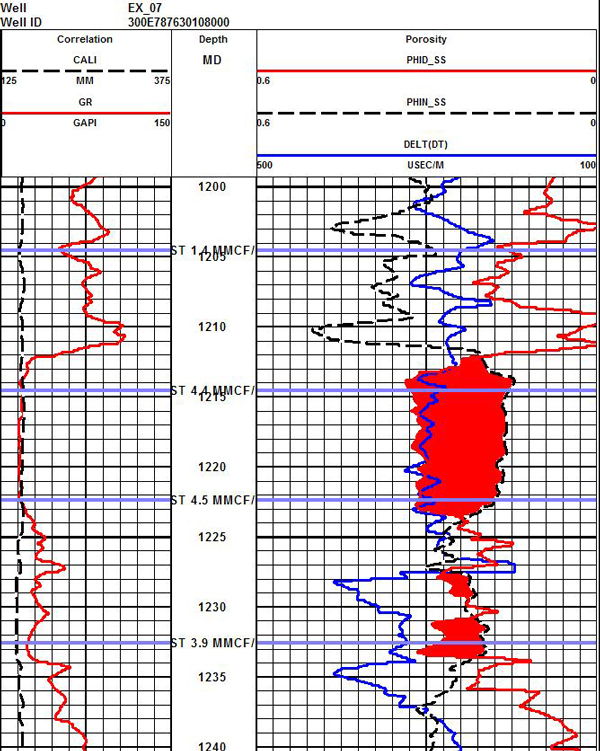
Image credit: Crain's Petrophysical Handbook, online at https://www.spec2000.net
Original at: https://www.spec2000.net/18-shalegas.htm
A | Water invaded zone |
B | Gas saturated zone |
C | Coal seam regions |
D | Water saturated zone |
E | Oil saturated zone |
Question 2 |

Image credit: Crain's Petrophysical Handbook, online at https://www.spec2000.net
A | Limestone |
B | Sandstone |
C | Dolomite |
D | Glauconitic Sandstone |
E | Anhydrite |
Question 3 |
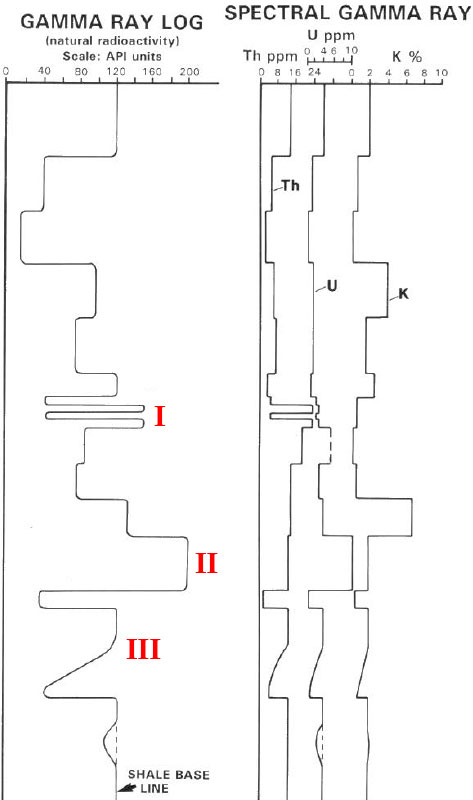
A | At position I |
B | Just below position II |
C | Just above position I |
D | Just above position II |
E | At position III |
Question 4 |

Image credit: Crain's Petrophysical Handbook, online at https://www.spec2000.net
A | Between ~1025 m and ~1028 m |
B | Between ~1042 m and ~1043 m |
C | Between ~1066 m and ~1071 m |
D | Between ~1070 m and ~1078 m |
E | Between ~1066 m and ~1078 m |
Question 5 |
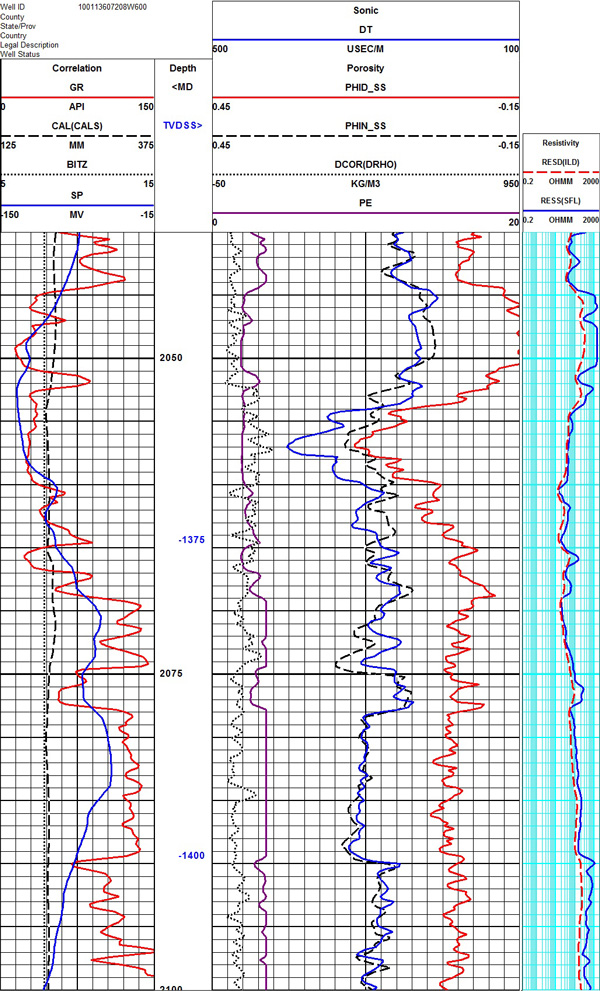
Image credit: Crain's Petrophysical Handbook, online at https://www.spec2000.net
A | Dolomite |
B | Sandstone |
C | Anhydrite |
D | Shale |
E | Limestone |
Question 6 |

Image credit: Crain's Petrophysical Handbook, online at https://www.spec2000.net
A | 2077 m (+/- 5m) |
B | 2057 m (+/- 5m) |
C | 2047 m (+/- 5m) |
D | 2047 m (+/- 5m) |
E | 2090 m (+/- 5m) |
Question 7 |
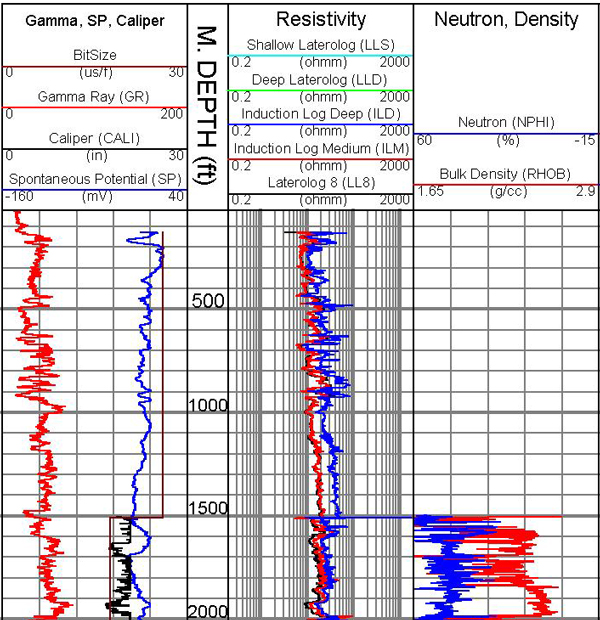
Image credit: United States Geological Survey, online at USGS database
A | Soft lithological facies |
B | Borehole collapse |
C | Drilling mud infiltration |
D | High pressure due to increased in depth |
E | Intentionally changed the drill bit |
Question 8 |
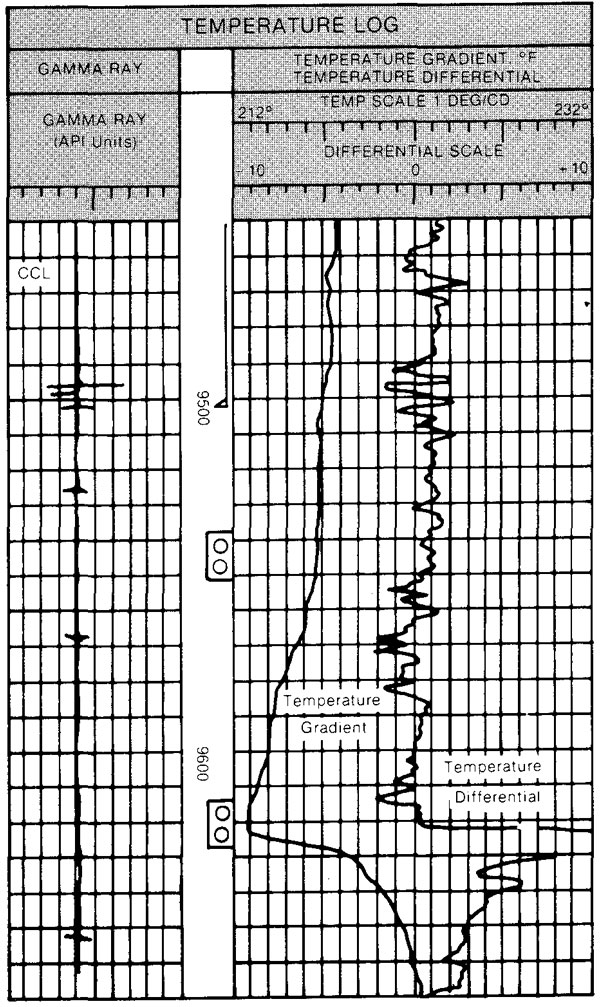
Image credit: Crain's Petrophysical Handbook, online at https://www.spec2000.net
Original at: https://www.spec2000.net/30-tmprlog.htm
A | From KB down to 9500 ft. |
B | From KB down to 9600 ft. |
C | Between 9550 ft to 9650 ft. |
D | Between 9500 ft and 9600 ft. |
Question 9 |

Image credit: Crain's Petrophysical Handbook, online at https://www.spec2000.net
Original at: https://www.spec2000.net/13-lithvisual.htm
A | Between 2970 m and 3075 m |
B | At 3075 m |
C | Between 2890 m and 2895 m |
D | Between 3075 m and 3085 m |
E | Between 2945 m and 2970 m |
Question 10 |

Image credit: Crain's Petrophysical Handbook, online at https://www.spec2000.net
Original at: https://www.spec2000.net/01-whatisalog.htm
A | High concentration of gas ("gas effect") |
B | Sandstone formation |
C | Coal bearing formation |
D | High porosity formation |
E | Presence of hydrocarbons |
Question 11 |

A | Low density shale |
B | Organic rich black shale |
C | Coal |
D | Heavy metals |
E | Shaly sandstone |
Question 12 |

Image credit: Crain's Petrophysical Handbook, online at https://www.spec2000.net
Original at: https://www.spec2000.net/13-lithvisual.htm
A | Channel point bar deposit |
B | Interbeds of coal and sand |
C | Transgressive marine shelf |
D | Prograding marine shelf |
E | Slope channel deposit |
Question 13 |

Image credit: Crain's Petrophysical Handbook, online at https://www.spec2000.net
Original at: https://www.spec2000.net/13-lithvisual.htm
A | At 2995 m |
B | At 3095 m |
C | At 2893 m |
D | At 3011 m |
E | At 2955 m |
Question 14 |

Image credit: Crain's Petrophysical Handbook, online at https://www.spec2000.net
Original at: https://www.spec2000.net/13-lithvisual.htm
A | ~75 |
B | ~1.0 |
C | ~0.013 |
D | 0.0 |
E | ~0.38 |
Net sand interval = 3075 m - 3000 m = 75 m (read off the GR curve)
Hence, net:gross = 75 m/75 m = 1.0
Question 15 |

Image credit: Crain's Petrophysical Handbook, online at https://www.spec2000.net
Original at: https://www.spec2000.net/22-fracloc5.htm
A | Fractures |
B | Effective porosity |
C | Lithological contacts |
D | Hydrocarbon saturated zones |
E | Bedding contacts |
F | Coal seams |
Question 16 |
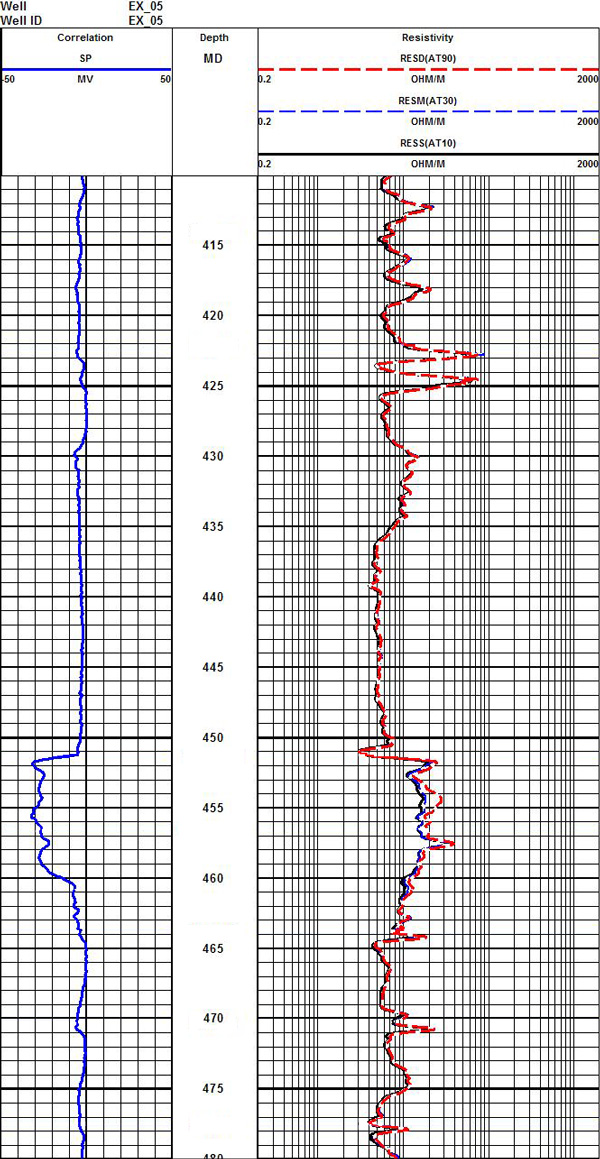
Image credit: Crain's Petrophysical Handbook, online at https://www.spec2000.net
Original at: https://www.spec2000.net/07-eslog.htm
A | Around 422 m of depth |
B | Around 470 m of depth |
C | Around 451 m of depth |
D | Around 460 m of depth |
E | Around 465 m of depth |
Question 17 |

Image credit: Crain's Petrophysical Handbook, online at https://www.spec2000.net
Original at: https://www.spec2000.net/18-shalegas.htm
A | Between 1209.5 m to 1211.5 m |
B | Between 1211.5 m to 1239.5 m |
C | Between 1212.5 m to 1223.5 m |
D | Between 1203 m to 1239.5 m |
Question 18 |

A | Interbeds of clean sand with shale |
B | Heavy metals |
C | Glauconitic sandstone |
D | Gas bearing sandstone |
E | Organic rich black shale |
Question 19 |
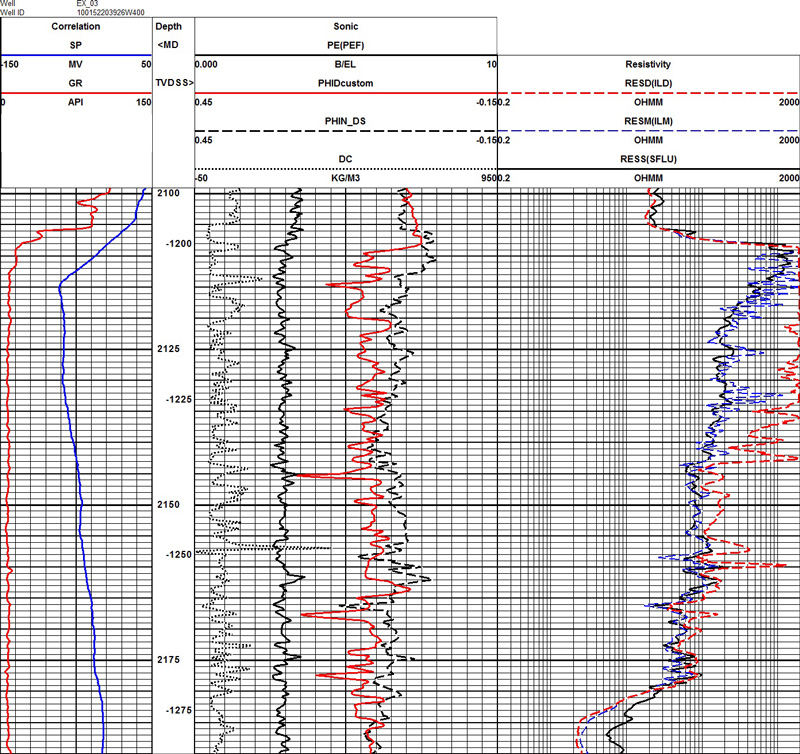
A | At around 2110 m of depth |
B | At around 2158 m of depth |
C | At around 2105 m of depth |
D | At around 2177 m of depth |
E | At around 2102 m of depth |
Question 20 |

Image credit: Crain's Petrophysical Handbook, online at https://www.spec2000.net
Original at: https://www.spec2000.net/22-fracloc5.htm
A | 50 degrees Southeast |
B | 150 degrees Northwest |
C | 60 degrees Southeast |
D | 30 degrees Northwest |
E | 40 degrees Southeast |
Question 21 |
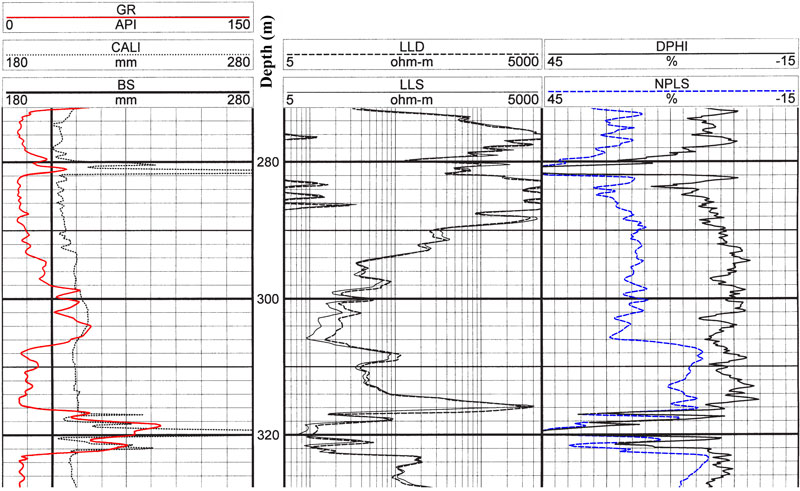
A | Low density bitumen |
B | Fresh water |
C | Natural gas |
D | Oil (petroleum) |
E | Brine water |
Question 22 |
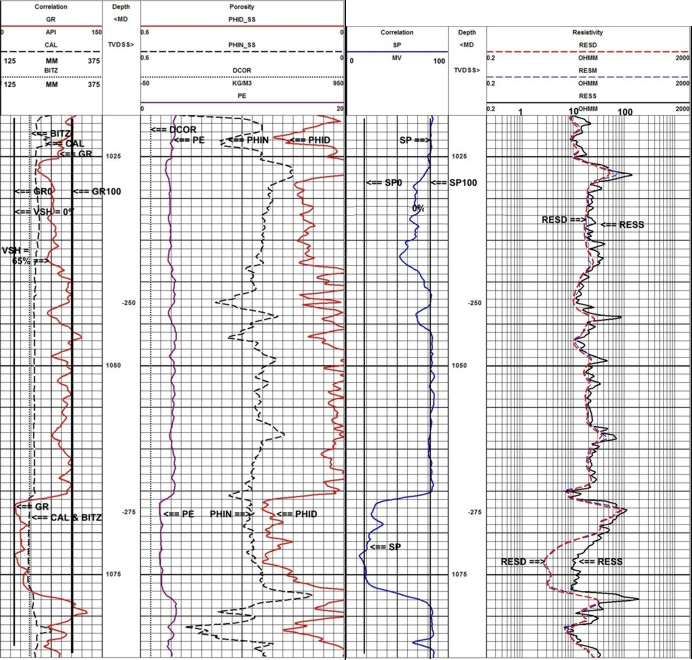
Image credit: Crain's Petrophysical Handbook, online at https://www.spec2000.net
Original at: https://www.spec2000.net/01-crainsrules.htm
A | At 1023 m |
B | At 1079 m |
C | At 1067 m |
D | At 1027 m |
E | At 1046.5 m |
Question 23 |

Image credit: Crain's Petrophysical Handbook, online at https://www.spec2000.net
A | Signal interference or poor tool calibration |
B | Inaccuracies in measurements due to mud infiltration |
C | Borehole collapse |
D | Tight oil |
E | Poor tool pads in the well |
Question 24 |

Image credit: Crain's Petrophysical Handbook, online at https://www.spec2000.net
Original at: https://www.spec2000.net/30-tmprlog.htm
A | 9500 ft |
B | 9540 ft |
C | 9640 ft |
D | 9600 ft |
E | 958 0ft |
Question 25 |

Image credit: Crain's Petrophysical Handbook, online at https://www.spec2000.net
Original at: https://www.spec2000.net/13-lithvisual.htm
A | Dolomite |
B | Argillaceous limestone |
C | Argillaceous dolomite |
D | Anhydrite |
E | Calcite |
F | Shale |
Question 26 |

A | Trangessive marine shelf |
B | Slope channel |
C | Prograding delta |
D | Braided channel |
E | Channel-point bar |
F | Super-fan depositional lobes |
Question 27 |

Original at: image log; Borehole image log analysis for sedimentary environment and clay volume interpretation by A. Shahinpour (NTUN) 2013
A | Fracture 4 and 5 |
B | Fracture 4, 6 and 7 |
C | It is impossible to determine. |
D | Fracture 3, 8 and 9 |
E | Fracture 5 and 6 |
Question 28 |

A | Interbedded clean sandstone and shale |
B | Coal |
C | Shale |
D | Sandstone |
E | Clean limestone |
Question 29 |

Image credit: Crain's Petrophysical Handbook, online at https://www.spec2000.net
Original at: https://www.spec2000.net/13-lithvisual.htm
A | Limy dolomite |
B | Shaly sandstone |
C | Quartz arenite |
D | Dolomitic pelmicrite |
E | Shale |
Question 30 |

Image credit: Crain's Petrophysical Handbook, online at https://www.spec2000.net
Original at: https://www.spec2000.net/07-eslog.htm
A | At around 416 m , 451 m , 464 m , 470 m and 475 m |
B | At around 414 m , 451 m , 457 m , 464 m and 475 m |
C | At around 416 m , 451 m , 457 m , 470 m and 475 m |
D | At around 412 m , 414 m , 422 m , 470 m and 475 m |
E | At around 414 m , 422 m , 464 m , 470 m and 477 m |
Question 31 |

Image credit: Crain's Petrophysical Handbook, online at https://www.spec2000.net
A | Sandtone |
B | Mudstone |
C | Caprock |
D | Seal |
E | Shale |
Question 32 |

Image credit: Crain's Petrophysical Handbook, online at https://www.spec2000.net
Original at: https://www.spec2000.net/13-lithvisual.htm
A | ~ 0.48 |
B | ~ 0.36 |
C | ~ 0.27 |
D | ~ 0.18 |
E | ~ 0.24 |
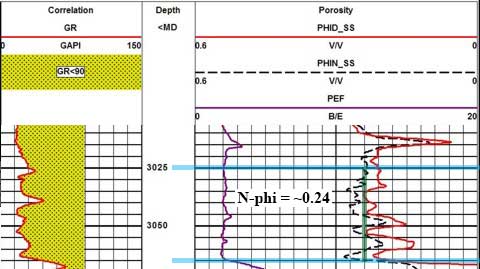
Question 33 |

Image credit: Crain's Petrophysical Handbook, online at https://www.spec2000.net
Original at: https://www.spec2000.net/13-lithvisual.htm
A | Limestone |
B | Shale |
C | Anhydrite |
D | Calcite |
E | Dolomite |
F | Argillaceous limestone |
Question 34 |

Image credit: Crain's Petrophysical Handbook, online at https://www.spec2000.net
Original at: https://www.spec2000.net/01-crainsrules.htm
A | Dolomite with clay interbeds |
B | Clean sand |
C | Carbonaceous sandstone |
D | Limestone with sand interbeds |
E | Dolomite |
Question 35 |

Image credit: Crain's Petrophysical Handbook, online at https://www.spec2000.net
Original at: https://www.spec2000.net/07-eslog.htm
A | AT30 (dashed blue line) |
B | AT90 (dashed red line) |
C | It is difficult to determine with the given log. |
D | AT10 (black line) |
Question 36 |
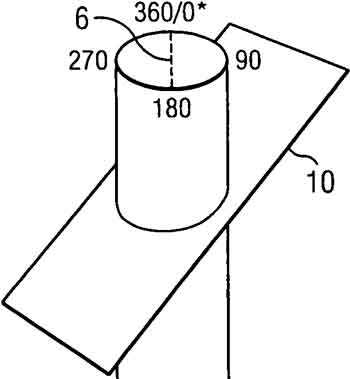

Original at: schematic diagram; http://www.google.com/patents/US20110064277
image log; Borehole image log analysis for sedimentary environment and clay volume interpretation by A. Shahinpour (NTUN) 2013
A | Fracture 8 and 9 |
B | Fracture 4 |
C | Fracture 7 |
D | Fracture 4 and 5 |
E | Fracture 1 and 2 |
Question 37 |

A | At around 2158 m of depth |
B | At around 2102 m of depth |
C | At around 2110 m of depth |
D | At around 2180 m of depth |
E | At around 2145m of depth |
Question 38 |

Image credit: Crain's Petrophysical Handbook, online at https://www.spec2000.net
Original at: https://www.spec2000.net/01-crainsrules.htm
A | Between 1047 m and 1060 m |
B | Between 1049 m and 1055 m |
C | Between 1071 m and 1078 m |
D | Between 1066 m and 1078 m |
E | Between 1066 m and 1071 m |
Question 39 |

Image credit: Crain's Petrophysical Handbook, online at https://www.spec2000.net
Original at: https://www.spec2000.net/13-lithvisual.htm
A | Shaly sandstone |
B | Feldspatic (K-spar rich) arenite |
C | Gas-bearing dolomite |
D | Gas-bearing sandstone |
E | Gas-bearing calcite |
F | Shale interbeded sandstone |
Question 40 |

Image credit: Crain's Petrophysical Handbook, online at https://www.spec2000.net
A | Between ~1042 m and ~1043 m |
B | Between ~1066 m and ~1078 m |
C | Between ~1025 m and ~1028 m |
D | Between ~1066 m and ~1071 m |
E | Between ~1070 m and ~1078 m |
← |
List |
→ |
| 1 | 2 | 3 | 4 | 5 |
| 6 | 7 | 8 | 9 | 10 |
| 11 | 12 | 13 | 14 | 15 |
| 16 | 17 | 18 | 19 | 20 |
| 21 | 22 | 23 | 24 | 25 |
| 26 | 27 | 28 | 29 | 30 |
| 31 | 32 | 33 | 34 | 35 |
| 36 | 37 | 38 | 39 | 40 |
| End |
Credits: Based on the excellent class notes provided by, Dr. Rudi Meyer during Fall 2014 and the generous support from CRAIN’S PETROPHYSICAL HANDBOOK (spec2000.net) by supplying the petrophysical well log images. Some of the welllogs are produced by E.R. Crain, P.Eng. Those logs obtianed from E.R. Crain is the copyrighted intellectual property of the author.
FAQ | Report an Error
Supplementary Materials
Petrophysical Techniques; Geology/Geophysics (449)
Introduction to Petroleum Geology (577)
CRAIN’S PETROPHYSICAL HANDBOOK (www.spec2000.net)
If you are a company or an organization willing to donate copies of well logs, please contact me. I really appreciate your contributions and proper credits will be provided.
